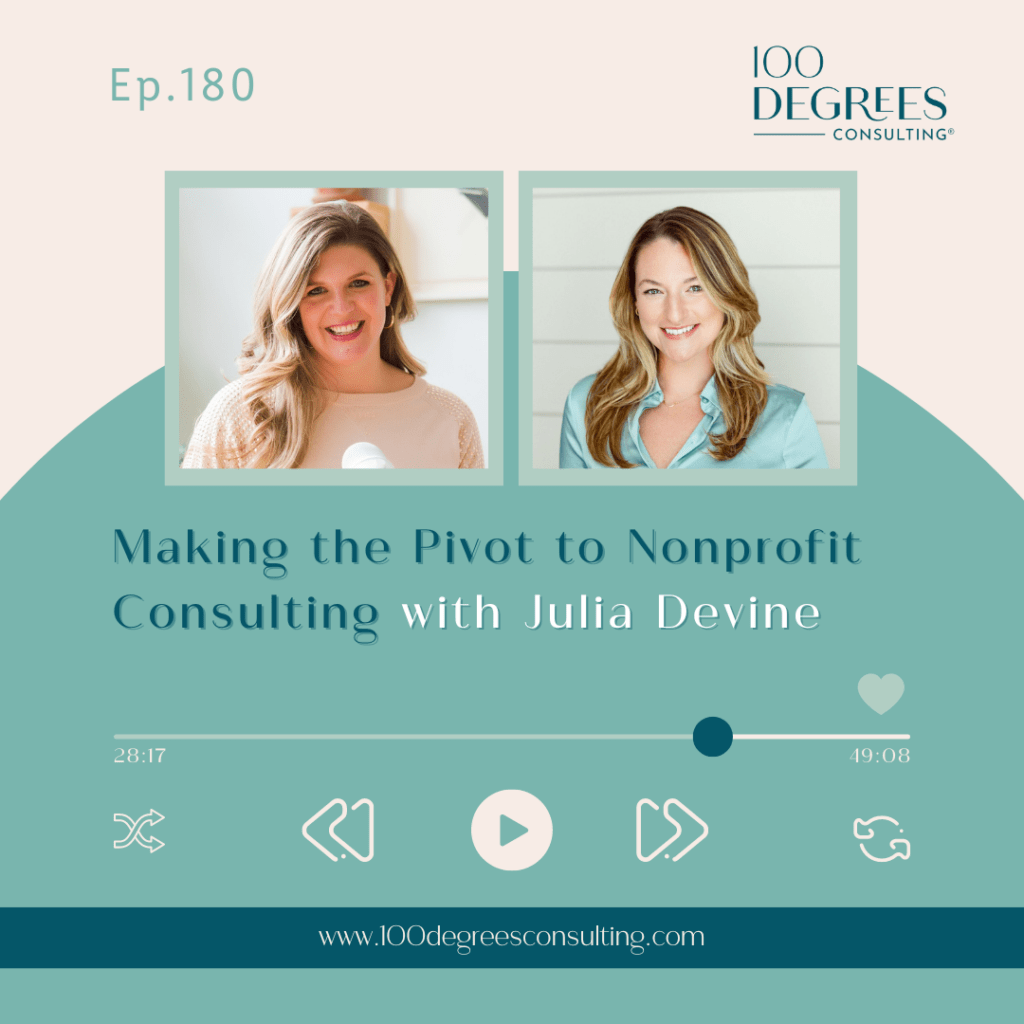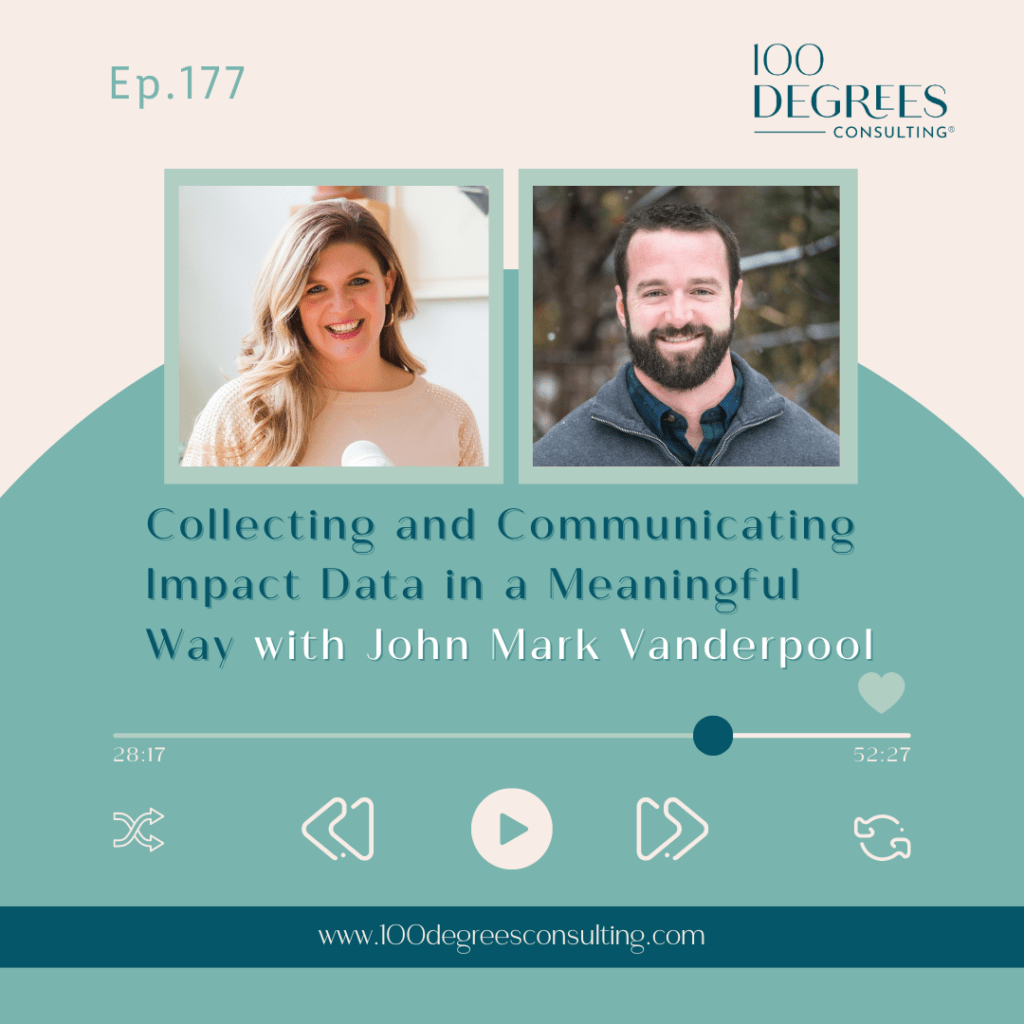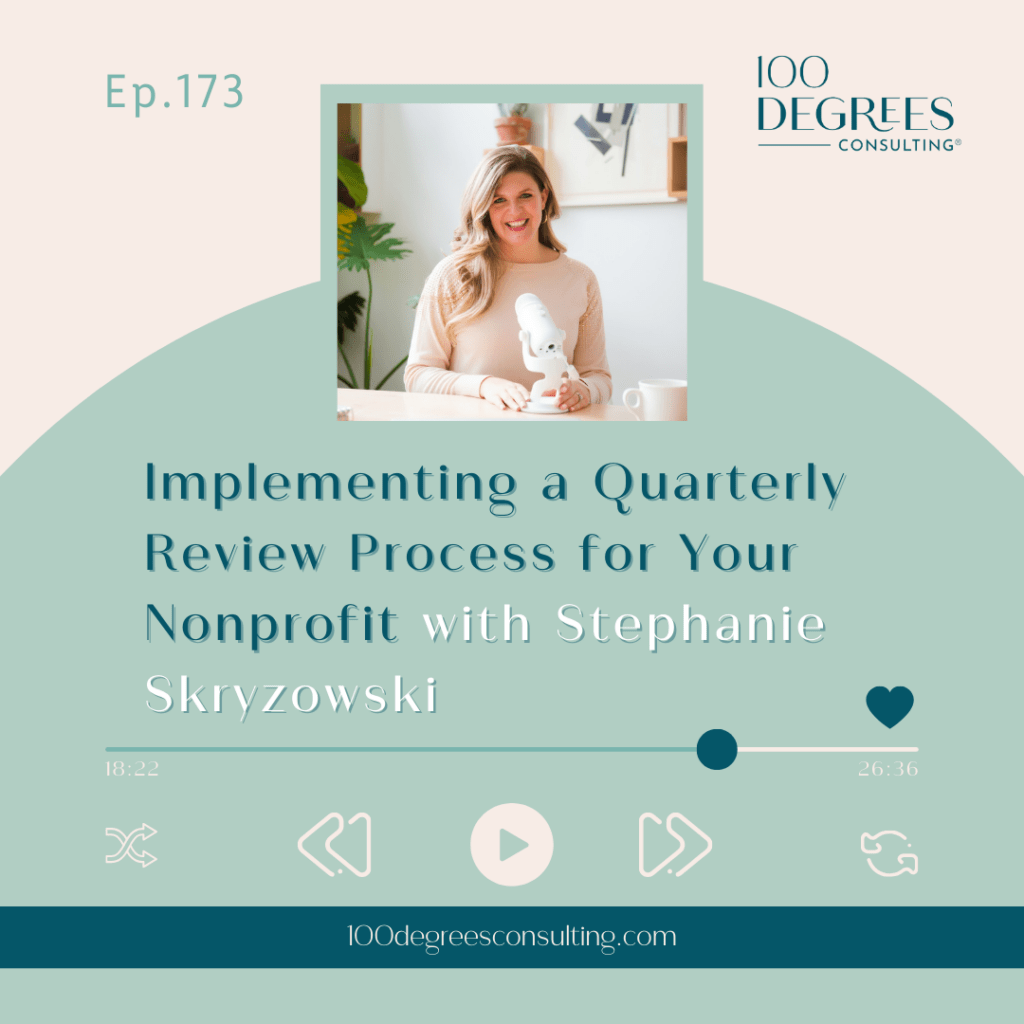Transcript Episode 162 – Leveraging the Power of Donor-Advised Funds with Mitch Stein on The Prosperous Nonprofit
[00:00:00] Stephanie Skryzowski: Welcome to the Prosperous Nonprofit, the podcast for leaders who are building financially sustainable and impactful nonprofits and changing the world. I’m Stephanie Skrzewski, a chief financial officer and founder and CEO of 100 Degrees Consulting. My personal mission is to empower leaders to better understand their numbers.To grow their impact and their income. On this show, we talk to people who are leading the nonprofit sector in new, innovative, disruptive, and entrepreneurial ways, creating organizations that fuel their lives, their hearts, and their minds. and their communities. Let’s dive in.
Hey, everybody. Welcome back to the Prosperous Nonprofit. I’m so excited you’re here with me today because I have a really awesome guest for you. So today I’m talking with Mitch Stein and he and I have been connected on LinkedIn for quite some [00:01:00] time. And as I said, on, on the episode, it feels like I’ve, I know him, but I think it’s just because he’s so prolific on LinkedIn and I follow him and we’ve kind of chatted behind the scenes on LinkedIn before, but.
Let me tell you all about him and then let me tell you what you are going to learn today in this episode. It’s a really, really good one. Okay. So Mitch is a social entrepreneur, a community builder, and an impact innovator. He’s currently the head of strategy for Chariot, a donor advised fund solution for nonprofits to maximize donor advised fund fundraising.
He previously founded a nonprofit marketplace and community called pond after leaving his role as a VP on Goldman Sachs technology investment banking team. He’s also a longtime board member at the LGBT center of New York city, and he’s an active alum of the startup leadership program in New York. Now, Mitch is awesome.
We talk a lot about pretty much the whole episode about donor advised funds. So if y’all are in any part of the nonprofit world, you’ve likely heard of donor [00:02:00] advised funds, but you may not know exactly what they are, what they mean, what they do, how to use them, how to find them. And Mitch is part of a team of a company called Chariot that helps connect donor advised funds with nonprofits.
Basically putting more money from donor advised funds into the hands of nonprofits. And so the way that they do this is so interesting. I’m going to leave it to him to explain, but I did ask him to explain donor advised funds. Like I am five. So that if you are feeling a little bit unsure of exactly what a donor advised fund is, but maybe like a little too nervous to raise your hand, Mitch has got you covered.
So. He’s going to break down exactly what the Donor Advice Fund, or DAF, that’s the, that’s the acronym, D A F, DAF, what the Donor Advice Fund economy looks like today and how more nonprofits can get their hands on this, like, over 230, uh, funds. Is it million? I think million dollars that are sitting in donor advice funds.
So [00:03:00] super practical, super interesting, and really educational and informative episode today. I think you are going to love it. Donor advice funds are rapidly changing the philanthropic landscape and And he’s going to teach us how to engage more effectively with this really fast growing segment of philanthropy.
So I think you’re going to love the episode. And also then at the end, I asked him for some personal advice and consulting advice. So you get to hear that at the end too. Anyway, I think you are going to love this episode. So without further ado, let’s go talk to Mitch.
Hey everybody. Welcome back to the Prosperous Nonprofit. I am really excited to be here with. Mitch Stein today, and today we’re going to talk all about donor advice funds and so much more. Uh, but Mitch, welcome to the podcast.
[00:03:50] Mitch Stein: Thank you. Thanks so much for having me, Stephanie. It’s great to be here. [00:03:54] Stephanie Skryzowski: Awesome.Yeah. Well, we were just talking before we started recording that we’ve been connected on LinkedIn [00:04:00] for a while and sort of wondering whether we had met before virtually. Um, and, uh, yeah, just really excited to kind of dig into what you are doing with chariot. So why don’t you start by. Let’s start with what you’re doing today.
Tell us about, you know, your work, chariot, all the things. And I’m going to get into like some probably like detailed questions, like explaining to me, like I’m five kinds of questions, but give us like the big picture right now.
[00:04:26] Mitch Stein: Yeah, of course. And it’s funny you mentioned about the, like, did we, did we not meet over because I feel like LinkedIn during the pandemic was the equivalent of like.A conference where you bumped into everybody and you’re like, did we talk there? Is that where we met? Um, so it’s, it’s fun actually getting back on the road and being at conferences and meeting people in person again. But yes, thank you for having me. Thank you for the intro and hey, everybody, don’t be scared.
We’re going to talk about generalized funds, but we’re going to make it very, very easy to understand and hopefully give you some nuggets of wisdom to bring back to your teams and your [00:05:00] donors. So my name is Mitch Stein. I’m the head of strategy at Chariot. We’re a company that helps nonprofits find more donor advised fund dollars and donors.
It’s a super fast growing segment of philanthropy. It’s been growing at over 20 percent per year for the past five years. Those are just like not numbers we see in the nonprofit world and in fundraising. So it’s really a changing tide in philanthropy that. It has come on quickly. And so a lot of people feel like, wait, I don’t know enough about Daxter, um, need to understand how they work better, but it’s okay.
You’re not too late. It’s the perfect time to start leveling up and, and planning and really developing strategy around it. In my role, I work on all things that are kind of growth related for our company, which includes engaging with nonprofits, engaging in educational resources and spaces like this in the podcast that you host, Stephanie.
We built a tool that allows nonprofits to collect donor [00:06:00] advised fund donations. Directly on their website or donation forms. And that means a donor with a DAF can use it just like they would a credit card on your checkout flow without ever leaving your page. And it’s about a 15 second and three click process compared with when they go through their own donor vice fund platform.
Uh, that takes minutes of time, which we all know in the non profit fundraising world, getting that time down to as little as possible is huge for conversion.
[00:06:27] Stephanie Skryzowski: Okay. So basically a donor could donate through their donor advice fund. So instead of like, making a donation through their fund. They have a fidelity, for example, they would have, there’s some sort of mechanism that chariot has created that allows a donor to give their donation directly to the organization on the website, using the form, but it’s still through their funds, they just don’t have to go through fidelity and then fidelity has to cut a check and then the organization gets it like four weeks later, like that kind of thing. [00:06:59] Mitch Stein: Yeah, [00:07:00] exactly. I mean, the problem that the reason we started and what we’re trying to solve is the fact that a DAF is like a charitable savings account for a donor. It’s like a wallet of money that they can only use to donate to charity, and yet they can’t use it in all the instances where they’re most likely to donate, which is when they’re inspired, which They’ve received your email, they’ve a friend’s doing a bike ride, they want to donate to their campaign, and they then have to leave that flow that you’ve so like obsessively, you know, crafted into the perfect conversion flow, they’re leaving it and going into another platform and maybe or maybe not converting to actually making a gift.And so by unifying the experience and putting it onto the nonprofits domain is a big unlock to. Just get more of those staff gifts. Um, they’re much larger and those donors tend to be really high potential, like major donors in general. But also, so that you know they made the gift right away, you can steward them [00:08:00] well right away.
You get their name and email and then the backend processing is all that much easier.
[00:08:05] Stephanie Skryzowski: So would you like in this, like, as I’m hearing you talk about this, it sounds like like an HSA account, right? Like a health savings account where it’s like, we have this money that like goes from your paycheck into this health savings account that you can only use for certain things.like you can use for charitable purposes for a donor advice fund. And then with the health savings account, they send you like a visa card that you can then swipe at different providers. So you don’t have to like, you know, go pay yourself and then get reimbursed in this whole process. You have this card that you can swipe instead.
So is it like, kind of like that?
[00:08:39] Mitch Stein: Yeah, really good comparison. We, we compare DAPS to HSAs or 401ks a lot, just so that people can kind of have a point of reference that it’s like, Oh, it’s, tax advantage dollars for a specific use case. And the challenge though is that you can’t have like A normal debit or credit card from a DAF because of that, like, [00:09:00] regulated use, it can only leave a DAF account to, uh, to be donated to the 501c3.And so that’s really the function that we’re performing as that, like, um, processor between a donor and a fund user that wants to use it out in the world. And the actual DAP account because we’re actually vetting the organization where that processing is taking place on their website because they have to register with us to receive those gifts where we can make sure there are 501c3 in good standing at the IRS.
It’s not for a ticket purchase, those kinds of restrictions on DAPs.
[00:09:33] Stephanie Skryzowski: Got it. Got it. Got it. That’s really cool. And I have your LinkedIn profile page open and the, the banner on your LinkedIn profile says it can’t wait. It’s you know, for your, for your company. And I love that. It can’t wait. You’re right.Let’s like back up like 20 steps just in case anybody listening is like. DAF? Donor Advised Fund? What is that? So, can you explain to us what a donor advised fund is? Like, [00:10:00] explain it like I’m five.
[00:10:01] Mitch Stein: Yeah, of course. So, um, anyone, any individual can have a donor advised fund account. You, me, your mom, your family member, anyone.They can set it up just like a normal bank account and they can put money into it, regular cash, or if they have something like securities, publicly traded stocks, bonds, or even like non publicly traded securities like a real estate asset or a piece of art. Like anything can be put into a donor advised fund account.
When you do that, you get a tax receipt back from the donor advised fund manager that you can write off the full value of what you contributed from your taxes. It’s now in an account where you can only take money out of it. To distribute to 501 C3 nonprofit organizations, but while it’s in the account, you can invest it just like the HSA example you raised like you can choose to invest in some mutual funds or specific securities that you can grow that balance while you’re holding it in reserve to use [00:11:00] to donate to nonprofits over time.
So it’s been really popular with people, especially if they have, like, a specific wealth event or they are compensated as part of their job with stock because when you donate, um, contribute stock into your DonorVized Fund account, you get that full write off and you avoid capital gains tax that you might have to owe on those securities.
So that was like the original reason why I would say people use DAX and why they got popular 10, 15 years ago. More on like the ultra high net worth end of the market. But what’s happened more recently. Is that they have been really exploding in the broader spectrum of donors where people are realizing, like, yes, there’s those tax benefits, and this is just a really good way to stay accountable to my goals with philanthropy.
So, like, I have a donor advised fund, and I contribute 100 a month to it, and it’s, My way of making sure that I’m like [00:12:00] staying true to goals, and I get a match for my employer who puts another 100 into my donor advice fund each month. So you’re seeing this like growth on both ends of the spectrum of like, Why people use the DAF, everything from like the super, super wealthy and kind of optimizing their taxes on down to kind of the rest of us, the more mass, uh, audience of donors who just want to do a better job.
[00:12:28] Stephanie Skryzowski: That makes so much sense. Yes. I love that explanation. Thank you. And why do people choose to put money into a donor advised fund versus just giving to the charity directly now? [00:12:40] Mitch Stein: Yeah, it’s a great question. And I think it’s also worth raising. And at this point too, that Dapps do come with a bit of controversy.Um, and I think it’s important for nonprofit fundraisers to be aware of that context where sometimes there’s like negative headlines around them because there’s 230 billion that are currently sitting [00:13:00] in donor advised funds that, according to the IRS, have been donated to charity, like tax receipts have been issued for that money, but it’s sitting in a bank account.
And not at a nonprofit. So a lot of people have rightly said, like, Oh, there’s all this money sitting on the sidelines. Like, we want to move more of it and activate it. And how can we make sure nonprofits are getting it faster? Um, and I think that’s some of the criticism to your point where someone might say, like, well, why are you giving it to your dad?
You should just make a donation. And I think that the important thing to remember is related to donor psychology. It’s like there’s actually two decisions being made anytime someone makes a gift, they’re determining how much they want to budget to charity in that moment. It’s like, okay, wait, I’m doing some mental calculation.
My name be subconscious. I’m like, Oh, yeah, I can give 100, 500, whatever my math is, I can give that away. The second decision is where do I want it to go? And [00:14:00] Whenever you combine those two decisions into one instance, it slows people down and they’re less likely to give. When, when you separate those decisions, so I’m making an intentional decision, 100 a month or whatever, our founders have all committed to donating 10 percent of their income to charity.
That’s why they’ve started the business, by the way. They’re trying to figure out good ways to manage that goal. Came across gaps and realize they were hard to use and started the tool. Uh, it’s a kind of a fun backstory. But in that instance, when you are making a commitment and making that that budget allocation separately.
Now I have money set aside that I can give. Strategically, I can really invest in how I want to give that money away, grow closer to those organizations, do my research, and have kind of like aside funds that are growing in the meantime to give out opportunistically with my friends running the marathon or someone’s doing a bike ride.
And you give way more because it’s like already set aside. It’s [00:15:00] not a current budget decision. So I just put all that out there to say that there are the world would be a better place if everyone who donated, in my opinion. We use adapt because they would be intentionally setting a goal, setting a budget, setting money aside and then putting it to work and ultimately giving more away.
The comparison is, in my opinion, not the best one to say like they put that money in adapt, they should give it to charity because they’re really just kind of front loading. Giving that they can do over time and the actual statistics about donor advised fund payouts are pretty high relative to what we’re used to from things like foundations.
Like they’ve been over 20%. Of the total balance on an annual basis since they started tracking it in 2000. So yes, we agree. Like, and that’s chariots goal is how do we move more of this money faster and and make sure people are using it more regularly and that dapps are more usable and also recognizing that, like, don’t do the baby [00:16:00] out with the bathwater, like the structure and format of a death is actually really valuable to engaging donors and your supporters and philanthropy.
[00:16:10] Stephanie Skryzowski: Mm hmm. You know, this is so helpful. Okay. So I, you know, like I was saying before I, we work with a ton of nonprofits and a lot of them are receiving donations through DAFs through donor advice funds. And I kind of always just had it in my head that like, well, this is like rich people that are just like putting all, you know, a bunch of money into this donor advice fund.And it’s only for rich people. And I was considering people like. Much, much wealthier than myself, but I really like this idea of like, it’s kind of like this savings account where you’re just like plugging money in just like you would if you had like a vacation fund, right? You’re plugging money in. So then that the ultimate payout is like, you go on this vacation that you saved up for.
And so. I guess as long as you spend it, you know, you put it in and then as long as you allocate it to a charity at some point, I really [00:17:00] like this. I’m like, okay, I need to set up a donor advice fund for myself now. So the work that y’all are doing at chariot is really on, it’s on the donor side of things, making the process easier for them to connect with organizations and get the money out of their donor advice fund to the charity.
Um, Like, this is a weird thing to say, what is the motivation, I guess, for a donor to get the funds out of their, you know, Fidelity or whatever account because they’ve already gotten the tax write off. So like, what is the, the push to get them to do that? And I know your solution. Is trying to make it easier for them.
But like, how are, did they, how are they seeing the urgency to move the funds out of there?
[00:17:44] Mitch Stein: Yeah, it’s a great question because, and we do tons of donor interviews as part of like, developing the products that we build at Chariot. And it is pretty shocking how many people are like, Oh, yeah, I have a DAF account.I haven’t looked. It’s been like a year since I looked how much money is in there. [00:18:00] It’s like, wait a second, you know, you don’t know, but it’s, um, I think that is more of a symptom of the problem we’re solving in that if I can’t use something anywhere, then yeah, I’m not going to think about it very often, you know, and it’s like, yeah, I am going to think about it once I’m doing my tax planning or like meeting with my accountant instead of um, Every time that I think about supporting a nonprofit, I can just use it right there.
I mean, just imagine you had a gift card that you couldn’t use. You had to go like log into your bank account to use your gift card at Starbucks. Like how likely are you to stop in Starbucks versus knowing how How usable gift card is and you walk in, you’re like, you’re gonna both use it more often and spend more money because the money it’s like whenever we already have allocated money to something, it’s like fun money.
It feels so much more like, I mean, and think about when you’re checking out somewhere with a gift card, what’s the first question you always [00:19:00] ask how much is on it because you’re planning like, Oh, yeah, I’m gonna just use all of it here. So there’s all this psychology that goes into it. That’s super interesting.
So your question of like. How do we actually appeal to a donor? I think is really important. Two of the ways that are kind of like a baseline thing that every nonprofit can do better is just highlighting donor advised funds as a way, as a way to give more prominently and more regularly. So having it in communications whenever you’re soliciting gifts.
having it, um, on your website and around your donation form. Just honestly reminding people that’s like a really good way to give and spelling the words out. Another tip that we share, um, that most donor advised fund donors aren’t familiar with the acronym DAF. So be sure to spell it out anywhere in your communications.
But yeah, I think making it more prominent is a big one. And then like you said, yes, making it easier. [00:20:00] Is definitely key. And yes, sure, it offers solutions to do that, but anyone can make it easier. Like if you have a section in your website. That highlights standardized fund giving share your E. I. N. right there so that if they are going back to their portal, they can plug it in and get the right organization.
Um, you know, share your legal name so that when it pops up on their portal, because that’s the other thing is these databases at the DAF are like a mess. That’s another thing that we help our nonprofit customers with is actually seeing how they’re listed across. I mean, there’s 1, 151 donor advised funds.
Everything from Fidelity, Vanguard, Schwab to, you know, like religious specific ones to basically every community foundation in the country. There’s so many of them and how organizations are listed, their name and their address can differ like in extreme ways across those. And it’s not just tiny organizations like this is true for some of our biggest customers where [00:21:00] we’ve had to go in and help them update it.
address information because checks could have just been going to the wrong place and they would have had no idea.
[00:21:08] Stephanie Skryzowski: You know, it’s so interesting that you say this. I literally got an email today from a donor advice fund to me. It is a former client that I no longer work with, but they reached out to me and they’re like, somebody from our donor advice fund wants to give to your organization, but we can’t find your address or the check got bounced.Like it bounced, it didn’t bounce, but the, it got sent back or whatever. And, And it’s really interesting that we’re having this conversation. I literally just got this email like a couple hours ago. So imagine how much money is just lost in the, you know, in the ether, in the universe, because of exactly what you’re saying.
That’s so interesting. And do you have a product that can like help nonprofits figure that out if they’re, you know, if there’s missing pieces or the address is wrong or the name’s wrong or something?
[00:21:59] Mitch Stein: Yeah. So we have a [00:22:00] tool called DaphScan, which a Doing just that, it’s scanning, uh, how an organization is listed within a database that all of the major JAFs are using.And like I said, this is when we worked with about 6, 000 nonprofits today. So we ran like a test, like an aggregate test across our current customers. Um, and over 40 percent of them had an inconsistency with their name or address. Like it’s, it’s, this is not like a rare occurrence. Some of them are like relatively minor.
But a lot of them are like the wrong, uh, you know, the wrong suite in an office building or the wrong building in a conflict, like these little things, but Like you won’t get your mail that way. It’s a real issue.
[00:22:40] Stephanie Skryzowski: Yeah. And I’m looking at, I have your website open and I’m just looking at a quote that says, we were shocked to find out there were over 100 different addresses for us across staff platforms.And that sounds like, like a pretty large organization, a hundred different addresses across these things. So think about like a hundred, you know, hundreds of donations that are never [00:23:00] making their way to nonprofits because of like, little silly admin things. That’s bananas.
[00:23:06] Mitch Stein: The other really frustrating thing, in my opinion, is that when these things happen, like which are happening all the time, a donor is with all the best intention going into their dapp account, making a gift, and then they’re reaching out to the non profit and saying like, well, I sent it.Yeah. Where is it? Or like, did you not get it? Did you lose it? Donors are having a bad impression of the non profit when it’s so not their fault, right? Like, the process is very broken and it’s frustrating to see it leave a bad impression of the organization’s, like, capabilities when there is, like, you know, this process is different for every single DAF.
Um, and and that’s a big thing we’ve we’ve helped to solve and are continuously improving on with chariots tools. Daphne is the name of our button [00:24:00] that can sit right on a donation form. But one of the biggest things is when that occurs on your checkout process, you get that donor’s name and email and the gift immediately.
So you now have insight into gift initiation to track it and understand when it’s missing. So you can reach out to the dap say like this was initiated three weeks ago. Why didn’t it come? Or you know, there’s just no one’s ever had that insight before because dap gifts were exclusively made off platform.
Um, and so it was just it just showed up and you had no insight into it. So being able to encourage. Donors to give in this way also helps you just make have more insight and information so that you don’t look like behind or not on top of your stuff when something is missing because it’s going to happen.
Checks aren’t going to arrive. We see this all the time, something we’re working on solutions for. But yeah, the actual back end processing stuff, all of your nonprofit fundraising listeners will definitely resonate with [00:25:00] these stories. Um, it’s something that happens all the time.
[00:25:04] Stephanie Skryzowski: Yeah, yeah. I mean, like, like what the email that I got this morning that was like, you know, this check came back.We have not been able to send it to you. Who do we send this to? I mean, that organization, I forwarded it to them to, you know, respond. But I mean, that could be potentially thousands and thousands of dollars that they’re not getting access to because of like administrative inefficiencies. And then, What’s the programmatic impact and they, you know, what could they have done with that thousands and thousands of dollars?
I don’t know. That’s really, really interesting.
Hey there. Amazing listeners. I hope you’re enjoying another fantastic episode of the prosperous nonprofit before we dive back in. I have a quick favor to ask. That’s right. If you are getting value, knowledge, encouragement, or even just good vibes from our show, please share the Prosperous Nonprofit with a friend or colleague [00:26:00] who you think would love it as much as you do.
It’s like passing along a good book or recommending your favorite local coffee spot. Please take a quick second to hit that share button, send a link, or even give a shout out on social media. Your support means the world to me. Thank you for being awesome. Thank you for being here. And now back to the show.
Okay. So, um, You’ve told us, um, we like definitely everyone needs to go check out give chariot. com because you will see all of the, all of the things that chariot does. But I would love to know, like, what should nonprofit leaders be doing? Like, what can they do right now to start kind of closing this gap and eliminating some of these, you know, administrative challenges?
Clunky things that will help them get access to more donor advice funds or, you know, kind of clean up the process for themselves. What should they be doing right now?
[00:26:56] Mitch Stein: Excellent question. I would say, first of all, Cherry [00:27:00] integrates with a number of fundraising platforms to enable like those three click dafe giving as a native feature.So double check our integration list. And if your current fundraising platform already has this as a feature, first of all, just make it, make sure it’s turned on. There’s no cost to turn that on and you’re just. Bringing in that new donor advice fund donors through your existing fundraising tools. So that’s number one, like definitely check and make sure and if they, if you don’t have a live integration, just be sure and ask your provider if that’s something you’re interested in.
Um, because we’re working to onboard more and more fundraising platforms every week. So separate and apart from working directly with chariot as a subscription customer, like that’s. A easy way to start using gap day without onboarding a new platform. But separate from that, I think there’s a couple main things that organizations should all be taking into account.
Number one is You’re already doing it. Checked on your listening to a podcast to learn more about donor [00:28:00] based funds. I think the best first step you can take is just increasing your own understanding and the capacity within your team. There’s been a lot of great research that’s been conducted on nonprofit organizations familiarity with DAPS, and it was something like less than 40 percent of fundraisers that said that they felt comfortable talking about DAPS with a donor.
And I just think it’s such obviously you’re, you’re not an advisor. You shouldn’t be playing that role. So like with appropriate disclaimers, but you don’t want to be telling someone what to do with their money or what accounts to set up. But being able to have an intelligent conversation about like, Oh, you’re thinking about using a DAF or your family has a DAF or your parents have a DAF, you know, tell me more about it.
And being comfortable in that space with a, in a one on one conversation with a donor is huge because that’s. building relationship, you’re getting more insight in how they think about their philanthropy. You’re now serving as a resource to them. Like there’s just so many benefits and this is a [00:29:00] really hot topic and it’s a really valuable business for financial advisors who are able to continue managing money and assets DAF account.
So I, I bring that up because people are going to be hearing about this from their financial advisors. And it’s coming up a lot and it’s a more and more popular topic. So having that understanding to have a good conversation is really key. So education, first and foremost, is huge. And just like spreading the word within your organization, making sure your leadership understands the importance of donor advised funds, your other fundraisers, your finance department.
Like it’s really something that as we’ve touched on, like it, it really affects Every part of the organization, and it’s something that’s been changing really quickly. So a lot of people don’t feel comfortable. Or, um, have a lot of backgrounds. There’s a ton of resources on our blog. I also share things about donor rights funds almost every day on LinkedIn.
So we can definitely connect there. But yeah, and I [00:30:00] try to also just pass on resources and helpful articles. So number one, first and foremost, is getting up to speed and increasing that education. And the second thing is something we were touching on earlier, is just making sure that you have in your communications and any time that you are engaging with donors.
Digitally, not in that one on one setting, but they also are being reminded about DAFs, making it easy and just kind of doing an audit of those things. I think that’s another good step to take that doesn’t require anything new or any new investments. It’s just looking at like, okay, do our solicitation emails mention donor advised funds as a way to get check?
Like, does our mailer say anything about donor advised funds? Do we have a place in our website that talks about this? Like that kind of checklist and audit is another really good step.
[00:30:47] Stephanie Skryzowski: Yeah, I love that. I mean, I just feel like with everything, people need multiple reminders. They’re not going to see something once and then it’s, you know, permanently implanted in their brain.They need to see it again and [00:31:00] again and again. And so I think that’s such great advice. Like keep reminding them, put it all over the place, put it in your emails, put it on your website. And yeah, I think that’s, that’s huge. And I was going to mention you, the blog and give chariot. com. Cause I think that, I mean, even this conversation, I feel so much more knowledgeable than I did before.
And so, you know, for any of our listeners to really feel like you can have an intelligent conversation about donor advised funds. There’s a lot of good stuff on the givechariot. com website. So before we, I feel like I want to, we could keep going with this, but I’d love to hear a little bit about your journey.
I know you’re, you’re a social entrepreneur, you’re a community builder, you are an impact innovator. How did you get to be doing what you’re doing right now? Tell us about your journey.
[00:31:50] Mitch Stein: Yeah, thank you for asking. I definitely had kind of an interesting path to the current work that I’m doing. I was an investment banker at Goldman Sachs for many years at the start of [00:32:00] my career.I went to school for finance and accounting, but kind of over time while I was in a few different roles at the company. I was also getting deeply invested in non profit work. Kind of outside of work, I started doing a bike ride fundraiser from Boston to New York called Cycle for the Cause, which is the Northeast AIDS ride that my dad and I started in 2016, or started participating in, in 2016 in honor of my uncle, Marlon, who he lost to AIDS.
And I’d done some volunteering and, and kind of fundraising things in the past, but that was something that really, like, Brought my whole family into a cause and an event super personal and meaningful to us and I just became kind of obsessed with it It’s probably putting it lightly and Over time we were raising like just seeing my dad.
We’re raising over a hundred thousand dollars a year I have like a donor file of like a thousand people and it really became like this deep Big undertaking that [00:33:00] I was sort of doing in my spare time, and I just started becoming more and more passionate about, like, improving the way things work and the tools that we were using.
And I was covering the technology software and Internet space as an investment banker so that Start how those worlds started to collide for me, and I ended up leaving my job to start a company called pond, which was a marketplace between nonprofit organizations and their vendors. So helping organizations find better tools and services, making sure they’re not paying too much for them, and I just felt like.
Uh, the sector is as we can all appreciate. It’s huge. There’s like over a million nonprofits, millions of people working at them. It’s such a vital, important part, not only of like society, but also a huge part of the economy. And how could we kind of organize the way that they’re doing business and working with different vendors into a single platform?
I worked on that for about three years. And an amazing experience built up, you know, an amazing network, uh, but ultimately we couldn’t just quite [00:34:00] get it to sustainably grow and kind of went the way of the vast majority of startups ended up having to close our doors. But I would say it was just a really clear now that I’m over a year past that point, like such a clear step.
Forward towards like the next thing. And this just shared effort with that community of how do we keep improving the sector and bringing better tools to market better solutions for people. And, um, that’s what led me to start working with chariot. I started consulting with a few different nonprofit technology companies over the course of last year.
One of those was chariot and they got me on on board full time. And I was just really inspired by the work they’re doing to unlock more of this funding for nonprofits, but also just, you know, every day we’re trying to think about innovations around stuff that everyone just assumed this was the way it worked.
Everyone just assumed that you had to go to your DAF platform and checks had to move in the mail and that was just the way it had to be done. And so I [00:35:00] just really love being somewhere where we don’t take anything for granted. Take it for granted. That’s not what I mean. We don’t, we don’t like take anything as like the way it has to be, which is such a refreshing attitude and so needed, uh, in our sector.
So I’m just really excited about everything you’re doing.
[00:35:18] Stephanie Skryzowski: Yeah, that’s what I mean. I’m just like nodding vigorously over here because I just agree. I mean, in, in the nonprofit sector, it does seem. In many, many ways that it’s like, well, this is the way we’ve always done it. And it’s like, okay, well, I, I guess that’s how we have to keep doing it.So I love that you’ve, you know, after your investment banking career, that you really made a career out of like technology innovation for nonprofits. And I don’t feel like there’s enough of that. I love that. And I love seeing this sort of entrepreneurial, innovative mindset. Going right into the nonprofit sector, we need it so, so much.
And that’s what this podcast is all about. Like talking about [00:36:00] organizations and people that are doing things in new, innovative, disruptive, entrepreneurial ways. Because I just think these are not conversations that the sector as a whole is having often enough.
[00:36:11] Mitch Stein: Yeah. [00:36:12] Stephanie Skryzowski: So, so cool. [00:36:14] Mitch Stein: I was just going to add because, um, we were speaking about this before we started recording, but I think.What I attribute a lot of those shortcomings to the fact that nonprofits are, like, subject to systems that they’re, like, recipients of. Like, the DAF is the perfect example, where, like, I’m not the customer of a donor advised fund as the nonprofit. Like, I’m getting money from them. So there’s just this power imbalance that I find super frustrating, and we hear this from nonprofit staff that we talk to all the time, that they’re, like, These donor voice funds have never spoken to a gift processor before they have no idea the headaches they’re creating for me and it’s like, just because we’re receiving the money, we should just accept [00:37:00] it.
However, it’s coming. And like, I just, that’s what gets me up and excited. And when I get out of bed in the morning, is that like, We’re in a position to really like customized solutions to the nonprofit specific problem, even in settings where they’ve traditionally not been like on the favorable end of a power imbalance.
And I just think there’s this is one example of that, but there’s like so many, particularly in like donor relationships or under relationships where like you’re receiving the money and so people think you should just put up with however it’s going to come. And it’s like, that’s just. So short sighted, you’re, you’re putting a burden on the organization, you’re limiting their impact, and it’s not achieving the goal anyone set out.
So anyway, I’ll step off my soapbox, but just reiterating what you’re getting at.
[00:37:47] Stephanie Skryzowski: Yeah, I completely agree because often I feel like my team and I were on the, we’re on the processing end of all of this. And so when things are clunky and the process is [00:38:00] not smooth, it costs organizations more money and like us more time to, to process them.And so what is that’s taking away resources. is that could be going elsewhere. Um, so yeah, completely agree with you. I’m really interested maybe from like a personal, maybe this is like a selfish question. I’m personally interested in like, what are the hardest parts of building technology for the nonprofit sector?
Like I said, I’m kind of asking for selfish reasons because I have this idea of a software related to financial management and forecasting and protection specifically for nonprofits that I’ve been sitting on for like five years because I’m too scared to like take action on it because I don’t like, it just feels like I’m jumping off a cliff into like this whole new world.
And so I’m like, I don’t even know where to start. So, um, what are the, maybe you should start with telling me the best part. No, start with telling me the hardest parts and then you can tell me the best parts to building technology for nonprofit. [00:39:00]
[00:39:00] Mitch Stein: Um, well, first of all, thank you for sharing. I feel like that’s kind of the hardest part when you have an idea for something is it’s, you’re almost like embarrassed or like, Oh, I don’t know if it’s going to work, so I don’t know if I should share it, but so thank you.For just like voicing that and wanting to talk about it because that’s the first step is just like getting it out there. That’s what starts to make it real is having conversation about it, especially in front of an audience, which you’re doing, which is super great. And I also think like your trepidation is warranted because it is really hard.
Like, I think. I experienced that firsthand. I, you know, in trying to build my startup, I honestly, one of the quick learnings I had was I moved too quickly into just building like a platform and trying to grow it before. I’m like, I should have spent a year where I was Like consulting for nonprofits to help them with vendor selection.
Like if I’d actually done the service and then tried to map a tool to it, which [00:40:00] is where I feel like you’re coming from, which is smart, like you’ve sort of validated the need for This solution because the existing solution is like a human spending their valuable time mapping out your so I think you’ve taken a really good step of like iterating on the more manual human driven process before you have a piece of technology.
So I think that’s really smart. The hardest part, though, is that distribution. Again, you have an existing client base, so you’re also a step ahead in, in how to kind of bring these things to market. I think for, uh, what I did, we tried to go the more traditional kind of startup route where you raise some increasing capital from angel investors and we’re trying to raise, you know, venture capital and like, how do we scale this super fast?
And I think things generally don’t scale in this space at a similar rate. Uh, other industries or end user audiences. And so that can [00:41:00] make it really difficult to meet the expectations of the VC. Does that mean that that’s the only way that you could develop a product or business and grow it? Absolutely not.
But that is just a big challenge. Like the distribution is tough. So if you’ve got like a special angle, like having an existing audience and customer base that you can start to develop a product with, that’s really smart. Yeah.
[00:41:22] Stephanie Skryzowski: Mm hmm. That’s so helpful. Thank you so much for sharing that, uh, sort of personal, personal consulting and coaching.I appreciate that.
[00:41:32] Mitch Stein: No, it’s I actually spent a lot of time Like I said, I was consulting for a lot of different founders of different kinds of startups in the social impact space last year, and I spent a lot of time thinking about, you know, could we create a fund that helps, like, invest in these types of businesses and get them off the ground?I ultimately decided, like, maybe at some point in the future, personally, I wasn’t in, like, a place where that could work for me, but I still talk to people about those kinds of things all the time. [00:42:00] And I, I feel like in the next few years. There’s going to be some dedicated, um, like philanthropy to the business of serving nonprofits because it doesn’t really, there isn’t someone today that is like missionally aligned to entrepreneurship around nonprofit organizations, which I think is a shame.
I think it’s a real shame that we don’t have more investment from philanthropy in businesses that serve nonprofits.
[00:42:28] Stephanie Skryzowski: Mm hmm. Yeah, I agree. I agree. It’s just sort of like widening the ecosystem. So I feel like, yeah, it’s got to be coming, but that’s a good point. Cause I feel like I’ve also kind of looked around and I’ve also looked around for funders who are interested in funding Like financial management education for nonprofits, um, because we have like an online course and workshops and things like that.And so I’ve looked for, you know, foundations and funders that are funding that type of work. And they’re like, They’re out [00:43:00] there, but they’re like few and far between. So,
[00:43:03] Mitch Stein: yeah, the capacity building is like, it’s been a bit of a buzzword, I think, in nonprofit funding before I was even, you know, more deeply involved in this sector.But I don’t. It’s your point. It’s like, people are talking about it, but are they changing their money going where their mouth is? I’m not sure how quickly that’s happening yet.
[00:43:23] Stephanie Skryzowski: Yeah, yeah, I agree. Okay, I feel like I could keep chatting with you, but I’m going to start to wrap us up. So one question that I always ask all of our guests before we leave is, what does a prosperous nonprofit look like to you? [00:43:40] Mitch Stein: Love that question. Um, I just think a culture, uh, Kind of continuous improvement is so valuable because it leaves the door open to people on your staff feeling empowered to want to improve things. And that might sound like simple or [00:44:00] obvious, but I’ve seen so many folks working in nonprofits that are like, get excited about some solution or like to a problem that they’re having internally or a new tool they want to try out or whatever.And then their manager is like, we don’t have any budget. Sorry. It’s just like stonewalling that kind of ideation around innovation. And, and I think. It’s such a shame to not foster that attitude in people and in the culture because there’s just always room to evolve and improve and that’s what is prospering, if not like evolving and improving.
[00:44:34] Stephanie Skryzowski: Yes. Mm. I love that. I love that. And I feel like that’s, that comes from this like startup entrepreneurial culture where you’re constantly. Yeah. Exactly. Ideating and coming up with new ideas and finding creative solutions. And I just, I want to see more of that in the sector as well. So I love that, that you mentioned that.Awesome. Mitch, this has been so great to chat with you. Tell all of our listeners, please, um, where they [00:45:00] can learn more about Chariot and where they can connect with you.
[00:45:04] Mitch Stein: Yeah, of course. So as I mentioned earlier, I’m very prolific on YouTube. So let’s definitely connect there. Um, and feel free to shoot me a message.Try to always respond to him. Um, but Mitch Stein on LinkedIn. Hopefully you’ll you’ll find me if you’re connected to Stephanie or you should find me quickly. And then my email is just Mitch at give chariot. com. So if it’s easier to reach out directly and you’ve got questions about. donor buys funds or chariot or anything.
I’m always happy to catch up.
[00:45:33] Stephanie Skryzowski: Awesome. Yes. Maybe that’s why I felt like we met because I follow you on LinkedIn and I feel like I know you and I’ve like followed along with your journey. So that probably is why I feel like if we’ve met before, right? Like, no, I just stalk you on LinkedIn. That’s how I feel like I know you. [00:45:49] Mitch Stein: I’ve heard it before. I’ve had people come up to me in coffee shop. At a wedding, at a restaurant. I think I follow you on LinkedIn. Yeah. [00:45:58] Stephanie Skryzowski: That’s so funny. Well, [00:46:00] you have 12, 000 followers, so I feel like the odds of that are pretty good. [00:46:05] Mitch Stein: Uh, yeah. I’m a huge fan of LinkedIn, so. [00:46:08] Stephanie Skryzowski: Yes, yeah. [00:46:10] Mitch Stein: Where I spend a lot of time. [00:46:13] Stephanie Skryzowski: Awesome. Well, thanks so much again for your time and everybody definitely go check out chariot@givechariot.com and then go find Mitch over on LinkedIn. Mitch, thanks so much for being here. [00:46:23] Mitch Stein: Thank you for having me. [00:46:26] Stephanie Skryzowski: Before you go, I just wanna thank you for being here. To access our show notes and bonus content, visit 100 degrees podcast.com.That’s 100 degrees podcast.com, and I’ll see you next time.



















